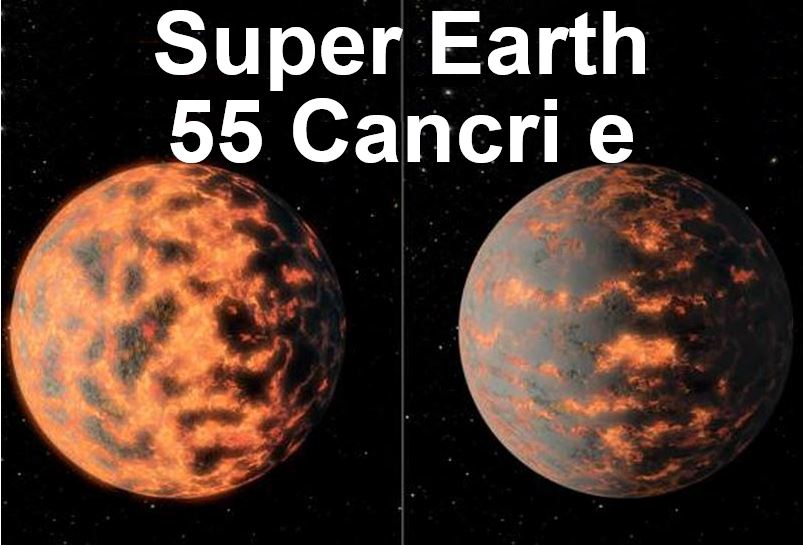A team of researchers has discovered an ultra-hot super Earth with wildly changing temperatures 40 light years from here – which in astronomical terms is ‘nearby’. The scientists believe the temperature fluctuations are probably due to massive amounts of volcanic activity.
Nicknamed the Diamond Planet, it is the first rocky exoplanet discovered so far where atmospheric variability has been observed. An exoplanet is a planet outside our Solar System that orbits a star.
In this study, led by researchers from the University of Cambridge in England, an almost threefold change in temperature over a two-year period was observed. They wrote about their findings in the e-print repository arXiv (citation below).

An artist’s impression of Cancri e, showing a hot partially-molten surface of the planet before and after likely volcanic activity on the day side. (Image: University of Cambridge. Credit: NASA/JPL-Caltech/R. Hurt)
Huge amounts of volcanic activity
Co-author Dr. Nikku Madhusudhan, of Cambridge’s Institute of Astronomy, and colleagues point out that although the cause of the atmospheric temperature variability is still being investigated, they are fairly certain it is caused by massive amounts of volcanic activity on the surface.
The ability to peer into the atmosphere of rocky exoplanets and see what conditions are like on their surfaces marks a major milestone towards identifying habitable planets in the Univervse.
Dr. Madhusudhan and team used NASA’s Spitzer Space Telescope to observe thermal emissions coming from the planet – officially called 55 Cancri e – which orbits a star much like our own Sun, in the Cancer constellation located 40 light years from Earth.
Wild temperature fluctuations
The astrophysicists detected rapidly changing conditions, with temperatures on the hot ‘day’ side of the exoplanet swinging from 1,000°C to 2,700°C.
Dr. Madhusudhan said:
“This is the first time we’ve seen such drastic changes in light emitted from an exoplanet, which is particularly remarkable for a super Earth.”
“No signature of thermal emissions or surface activity has ever been detected for any other super Earth to date.”
According to their preliminary interpretations of the new data, the variability in temperature may be due to massive plumes of dust and gas that occasionally cover the whole surface, which may be partially molten.
The plumes are most likely caused by incredibly high rates of volcanic activity, greater than what has been observed in one of Jupiter’s moons ‘Io’; our Solar System’s most active body.
Lead author, Dr. Brice-Olivier Demory, of the University of Cambridge’s Cavendish Laboratory, said:
“We saw a 300 percent change in the signal coming from this planet, which is the first time we’ve seen such a huge level of variability in an exoplanet.”
“While we can’t be entirely sure, we think a likely explanation for this variability is large-scale surface activity, possibly volcanism, on the surface is spewing out massive volumes of gas and dust, which sometimes blanket the thermal emission from the planet so it is not seen from Earth.”
55 Cancri e does not rotate
55 Cancri e has about eight times the mass (total weight) and twice the volume (size) of Earth. It is very close to its star, in fact, one 55 Cancri e year lasts only 18 hours.
The planet is tidally locked; this means it does not rotate like our planet does – instead there is a permanent ‘night’ and ‘day’ side.
The authors wrote:
“Since it is the nearest super Earth whose atmosphere can be studied, 55 Cancri e is among the best candidates for detailed observations of surface and atmospheric conditions on rocky exoplanets.”
The majority of early studies on exoplanets have been on Saturn- and Jupiter-like gas giants, because their massive size makes it easier to find them.
Over the last few years, astronomers have been able to map the conditions on several of these gas giants. It is much more difficult to do this with super Earths. A super Earth is a planet with from one to ten times the mass of our planet.
Initial observations of 55 Cancri e pointed to an abundance of carbon, suggesting that the exoplanet was composed of diamond. However, these latest results have muddied those early observations significantly and sparked a whole new set of questions.
Dr. Madhusudhan said:
“When we first identified this planet, the measurements supported a carbon-rich model. But now we’re finding that those measurements are changing in time. The planet could still be carbon rich, but now we’re not so sure – earlier studies of this planet have even suggested that it could be a water world.”
“The present variability is something we’ve never seen anywhere else, so there’s no robust conventional explanation. But that’s the fun in science – clues can come from unexpected quarters.”
“The present observations open a new chapter in our ability to study the conditions on rocky exoplanets using current and upcoming large telescopes.”
The paper was also co-authored by Dr. Michaël Gillon of the Université of Liège in Belgium, and Professor Didier Queloz of the Cavendish Laboratory.
In separate study, researchers from the Australian National University announced earlier this week that they discovered a massive exoplanet, about the size of Jupiter (317.8 Earth mass), orbiting very-close to a small cool star approximately 500 light years from our Solar System. They said their finding challenges current ideas about planet formation.
Citation: “Variability in the super-Earth 55 Cnc e,” Brice-Olivier Demory, Michael Gillon, Nikku Madhusudhan, Didier Queloz. arXiv. Submitted on 1 May, 2015. Cited as arXiv:1505.00269 [astro-ph.EP].
Video – Nearby Super Earth

